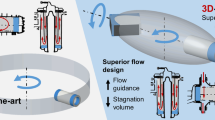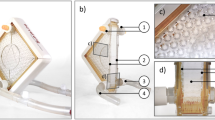Abstract
The pediatric pump-lung (PediPL) is a miniaturized integrated pediatric pump-oxygenator specifically designed for cardiac or cardiopulmonary support for patients weighing 5–20 kg to allow mobility and extended use for 30 days. The PediPL incorporates a magnetically levitated impeller with uniquely configured hollow fiber membranes (HFMs) into a single unit capable of performing both pumping and gas exchange. A combined computational and experimental study was conducted to characterize the functional and hemocompatibility performances of this newly developed device. The three-dimensional flow features of the PediPL and its hemolytic characteristics were analyzed using computational fluid dynamics based modeling. The oxygen exchange was modeled based on a convection–diffusion–reaction process. The HFMs were modeled as a porous medium which incorporates the flow resistance in the bundle by an added momentum sink term. The pumping function was evaluated for the required range of operating conditions (0.5–2.5 L/min and 1000–3000 rpm). The blood damage potentials were further analyzed in terms of flow and shear stress fields, and the calculations of hemolysis index. In parallel, the hydraulic pump performance, oxygen transfer, and hemolysis level were quantified experimentally. Based on the computational and experimental results, the PediPL is found to be functional to provide necessary oxygen transfer and blood pumping requirements for the pediatric patients. Smooth blood flow characteristics and low blood damage potential were observed in the entire device. The in vitro tests further confirmed that the PediPL can provide adequate blood pumping and oxygen transfer over the range of intended operating conditions with acceptable hemolytic performance. The rated flow rate for oxygenation is 2.5 L/min. The normalized index of hemolysis is 0.065 g/100 L at 1.0 L/min and 3000 rpm.









Similar content being viewed by others
References
American Heart Association. Congenital Cardiovascular Defects—Statistics. American Dallas: Heart Association, 2009.
American Society for Testing and Materials. ASTM F1841-97: Standard Practice for Assessment of Hemolysis in Continuous Flow Blood Pumps, 2004.
Arens, J., H. Schnoering, M. Pfennig, I. Mager, J. F. Vázquez-Jiménez, T. Schmitz-Rode, et al. The Aachen MiniHLM—a miniaturized heart–lung machine for neonates with an integrated rotary blood pump. Artif. Organs 34:707–713, 2010.
Baldwin, J. T., H. S. Borovetz, B. W. Duncan, M. J. Gartner, R. K. Jarvik, and W. J. Weiss. The National Heart, Lung, and Blood Institute Pediatric Circulatory Support Program: a summary of the 5-year experience. Circulation 123:1233–1240, 2011.
Baldwin, J. T., H. S. Borovetz, B. W. Duncan, M. J. Gartner, R. K. Jarvik, W. J. Weiss, and T. R. Hoke. The national heart, lung, and blood institute pediatric circulatory support program. Circulation 113:147–155, 2006.
Bartlett, R. H. Extracorporeal life support: history and new directions. Semin. Perinatol. 29:2–7, 2005.
Blackshear, P. L. Mechanical hemolysis in flowing blood. In: Biomechanics: Its Foundation and Objectives, edited by Y. C. Fung. Englewood Cliffs, NJ: Prentice-Hall, 1972, pp. 501–528.
de Simone, G., R. B. Devereux, S. R. Daniels, G. Mureddu, M. J. Roman, T. R. Kimball, et al. Stroke volume and cardiac output in normotensive children and adults: assessment of relations with body size and impact of overweight. Circulation 95:1837–1843, 1997.
Duncan, B. W., D. J. Bohn, A. M. Atz, J. W. French, P. C. Laussen, and D. L. Wessel. Mechanical circulatory support for the treatment of children with acute fulminant myocarditis. J. Thorac. Cardiovasc. Surg. 122:440–448, 2001.
Ergun, S. Fluid flow through packed columns. Chem. Eng. Prog. 48:89–94, 1952.
Fraser, K. H., M. E. Taskin, B. P. Griffith, and Z. J. Wu. The use of computational fluid dynamics in the development of ventricular assist devices. Med. Eng. Phys. 33:263–280, 2011.
Haines, N. M., P. T. Rycus, J. B. Zwischenberger, R. H. Bartlett, and A. Undar. Extracorporeal life support registry report 2008: neonatal and pediatric cardiac cases. ASAIO J. 55:111–116, 2009.
International Organization for Standardization. ISO 7199: Cardiovascular Implants and Artificial Organs-Blood Gas Exchangers (Oxygenators), 1st edn., 1996.
James, N. L., C. M. Wilkinson, N. L. Lingard, A. L. Van der Meer, and J. C. Woodard. Evaluation of hemolysis in the VentrAssist implantable rotary blood pump. Artif. Organs 27:108–113, 2003.
Jikuya, T., T. Tsutsui, O. Shigeta, Y. Sankai, and T. Mitsui. Species differences in erythrocyte mechanical fragility: comparison of human, bovine, and ovine cells. ASAIO J. 44:M452–M455, 1998.
Kawahito, S., T. Maeda, T. Motomura, H. Ishitoya, T. Takano, K. Nonaka, et al. Hemolytic characteristics of oxygenators during clinical extracorporeal membrane oxygenation. ASAIO J. 48:636–639, 2002.
Kopp, R., R. Bensberg, J. Arens, U. Steinseifer, T. Schmitz-Rode, R. Rossaint, et al. A miniaturized extracorporeal membrane oxygenator with integrated rotary blood pump: preclinical in vivo testing. ASAIO J. 57:158–163, 2011.
Svitek, R. G., B. J. Frankowski, and W. J. Federspiel. Evaluation of a pumping assist lung that uses a rotating fiber bundle. ASAIO J. 51:773–780, 2005.
Svitek, R. G., D. E. Smith, and J. A. Magovern. In vitro evaluation of the TandemHeart pediatric centrifugal pump. ASAIO J. 53:747–753, 2007.
Taskin, M. E., T. Zhang, B. Gellman, A. Fleischli, K. A. Dasse, B. P. Griffith, et al. Computational characterization of flow and hemolytic performance of the UltraMag(™) blood pump for circulatory support. Artif. Organs 34(12):1099–1113, 2010.
Zhang, T., G. Cheng, A. Koert, J. Zhang, B. Gellman, G. K. Yankey, et al. Functional and biocompatibility performances of an integrated Maglev pump-oxygenator. Artif. Organs 33:36–45, 2009.
Zhang, J., B. Gellman, A. Koert, K. A. Dasse, R. J. Gilbert, B. P. Griffith, et al. Computational and experimental evaluation of the fluid dynamics and hemocompatibility of the CentriMag blood pump. Artif. Organs 30:168–177, 2006.
Zhang, J., T. D. C. Nolan, T. Zhang, B. P. Griffith, and Z. J. Wu. Characterization of membrane blood oxygenation devices using computational fluid dynamics. J. Membr. Sci. 288:268–279, 2007.
Zhang, J., M. E. Taskin, A. Koert, T. Zhang, B. Gellman, K. A. Dasse, et al. Computational design and in vitro characterization of an integrated Maglev pump-oxygenator. Artif. Organs 33:805–817, 2009.
Zhang, T., M. E. Taskin, H. B. Fang, A. Pampori, R. Jarvik, B. P. Griffith, et al. Study of flow-induced hemolysis using novel Couette-type blood-shearing devices. Artif. Organs 2011. doi:10.1111/j.1525-1594.2011.01243.x. [Epub ahead of print].
Acknowledgments
This study was supported in part by the National Institutes of Health (Contract Number: HHSN268201000014C and Grant Numbers: R42HL084807, R01HL082631, R01HL088100).
Author information
Authors and Affiliations
Corresponding author
Additional information
Associate Editor Keefe B. Manning oversaw the review of this article.
Rights and permissions
About this article
Cite this article
Wu, Z.J., Gellman, B., Zhang, T. et al. Computational Fluid Dynamics and Experimental Characterization of the Pediatric Pump-Lung. Cardiovasc Eng Tech 2, 276–287 (2011). https://doi.org/10.1007/s13239-011-0071-5
Received:
Accepted:
Published:
Issue Date:
DOI: https://doi.org/10.1007/s13239-011-0071-5




